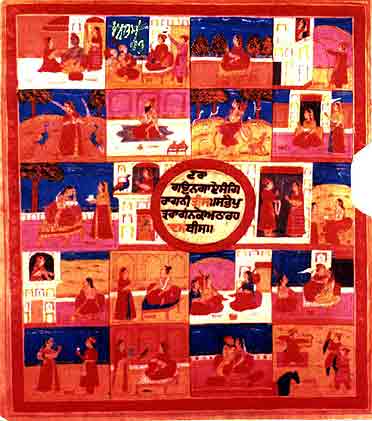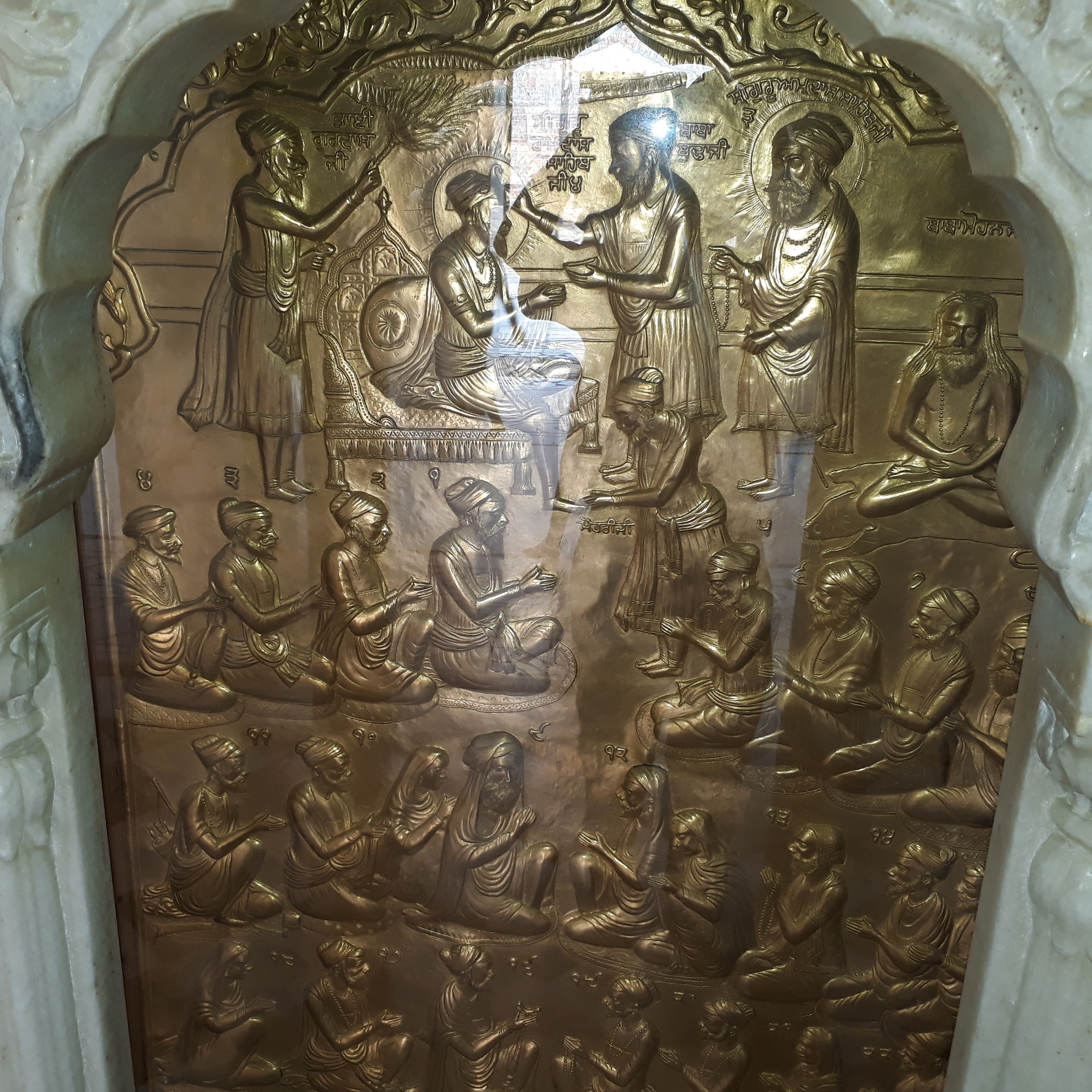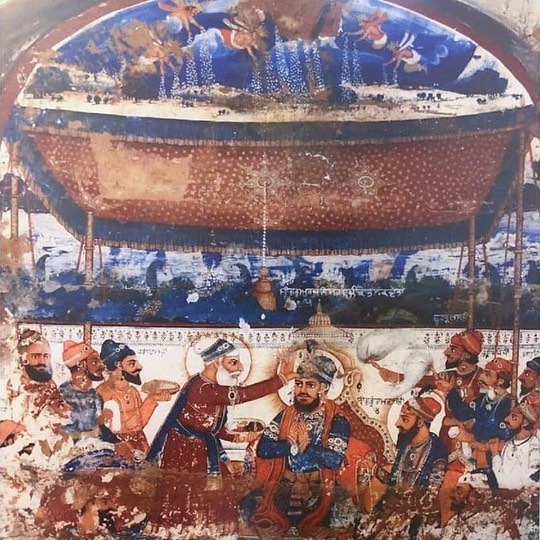|
Bairari
This is an India musical raga (composition) that appears in the Sikh tradition from northern India and is part of the Sikh holy scripture called Sri Guru Granth Sahib or Guru Granth Sahib for short. Every raga has a strict set of rules which govern the number of notes that can be used; which notes can be used; and their interplay that has to be adhered to for the composition of a tune. In the Guru Granth Sahib, the Sikh holy Granth (book) there are a total of 31 raga compositions and this raga is the ninth raga to appear in the series. The composition in this raga appear on a total of only 2 pages from page numbers 719 to 721. This raga appears in the Ragmala as the first ragini ("subset") of Sri raga. In the Mesakarna Ragmala (1509), which is almost the same as that of the Guru Granth Sahib, the first ragini of Siri Raga is given as Vairati. However, modern sources do not give Bairari nor Vairati but Barari and Varari as well as Varati are listed. Kaufmann believes that all ... [...More Info...] [...Related Items...] OR: [Wikipedia] [Google] [Baidu] |
Sri Guru Granth Sahib
The Guru Granth Sahib (, ) is the central holy religious scripture of Sikhism, regarded by Sikhs as the final, sovereign and eternal Guru following the lineage of the ten human gurus of the religion. The Adi Granth (), its first rendition, was compiled by the fifth guru, Guru Arjan (1564–1606). Its compilation was completed on 29 August 1604 and first installed inside the Golden Temple in Amritsar on 1 September 1604. Baba Buddha was appointed the first Granthi of the Golden Temple. Shortly afterwards Guru Hargobind added Ramkali Ki Vaar. Later, Guru Gobind Singh, the tenth Sikh guru, added hymns of Guru Tegh Bahadur to the Adi Granth and affirmed the text as his successor. This second rendition became known as the Guru Granth Sahib and is also sometimes referred to as the Adi Granth.Adi Granth Encyclopaedia Britan ... [...More Info...] [...Related Items...] OR: [Wikipedia] [Google] [Baidu] |
Raga
A raga ( ; , ; ) is a melodic framework for improvisation in Indian classical music akin to a musical mode, melodic mode. It is central to classical Indian music. Each raga consists of an array of melodic structures with musical motifs; and, from the perspective of the Indian tradition, the resulting music has the ability to "colour the mind" as it engages the emotions of the audience. Each raga provides the musician with a musical framework within which to improvise. Improvisation by the musician involves creating sequences of notes allowed by the raga in keeping with rules specific to the raga. Ragas range from small ragas like Bahar (raga), Bahar and Sahana (raga), Sahana that are not much more than songs to big ragas like Malkauns, Darbari and Yaman (raga), Yaman, which have great scope for improvisation and for which performances can last over an hour. Ragas may change over time, with an example being Marwa (raga), Marwa, the primary development of which has been going down ... [...More Info...] [...Related Items...] OR: [Wikipedia] [Google] [Baidu] |
Sikh
Sikhs (singular Sikh: or ; , ) are an ethnoreligious group who adhere to Sikhism, a religion that originated in the late 15th century in the Punjab region of the Indian subcontinent, based on the revelation of Guru Nanak. The term ''Sikh'' has its origin in the Sanskrit word ', meaning 'seeker', or . According to Article I of Chapter 1 of the Sikh ''Rehat Maryada'' (), the definition of Sikh is: Any human being who faithfully believes in One Immortal Being Ten Gurus, from Guru Nanak Sahib to Guru Gobind Singh Sahib The Guru Granth Sahib The utterances and teachings of the ten Gurus and The initiation, known as the Amrit Sanchar, bequeathed by the tenth Guru and who does not owe allegiance to any other religion, is a Sikh. Male Sikhs generally have '' Singh'' () as their last name, though not all Singhs are necessarily Sikhs; likewise, female Sikhs have '' Kaur'' () as their last name. These unique last names were given by the Gurus to allow Sikhs to stand out ... [...More Info...] [...Related Items...] OR: [Wikipedia] [Google] [Baidu] |
India
India, officially the Republic of India, is a country in South Asia. It is the List of countries and dependencies by area, seventh-largest country by area; the List of countries by population (United Nations), most populous country since 2023; and, since its independence in 1947, the world's most populous democracy. Bounded by the Indian Ocean on the south, the Arabian Sea on the southwest, and the Bay of Bengal on the southeast, it shares land borders with Pakistan to the west; China, Nepal, and Bhutan to the north; and Bangladesh and Myanmar to the east. In the Indian Ocean, India is near Sri Lanka and the Maldives; its Andaman and Nicobar Islands share a maritime border with Thailand, Myanmar, and Indonesia. Modern humans arrived on the Indian subcontinent from Africa no later than 55,000 years ago., "Y-Chromosome and Mt-DNA data support the colonization of South Asia by modern humans originating in Africa. ... Coalescence dates for most non-European populations averag ... [...More Info...] [...Related Items...] OR: [Wikipedia] [Google] [Baidu] |
Ragmala
Ragmala, alternatively spelt as Raagmala or Ragamala ( Punjabi: ਰਾਗਮਾਲਾ ; pronounced rāgmālā,) is a composition of twelve verses (sixty lines) that names various raga''.'' These raga appear in the ''saroops'' of Guru Granth Sahib, after the compositions of Guru Arjan entitled ''Mundavani'' (ਮੁੰਦਾਵਣੀ; meaning "The Royal Seal".) The title literally means a 'Garland of Raga’, or a ‘Mode of Musical Melodies’ - "mala" means "garland", while "raga" means “musical composition or mode.” This work has inspired the series of Ragamala paintings. The list differs according to the author and the music school it is based upon. Variations on these lists can be found in the music text books of India. Bhagat Singh (1718), a contemporary of Bhai Mani Singh illustrates in Gurbilas Patshahi 6, that the Ragas where distressed as artists were singing daughters with fathers, cousins together, mom and son together breaking the relations as well as not singi ... [...More Info...] [...Related Items...] OR: [Wikipedia] [Google] [Baidu] |
Shree (Hindustani Raga)
Shree is a very old North Indian raga of the Purvi thaat, and has traditionally been associated with Laxmi. It also appears in the Sikh tradition from northern India, and is a part of the ''Guru Granth Sahib'', the holy text of the Sikhs. The Guru Granth Sahib composition comprises 31 ragas where Shree is the first raga to appear. The raga appears first on 14th page of the composition. The basis of this Raag is steeped in the traditions of mainstream Indian Classical music. Siri Raag is serious and thought-provoking in its nature and creates an atmosphere where the listener is led to heed the advice given therein. The listener (the mind) is made aware of the truth of the message and with this ‘education’ is given the strength to face the future with both humility and the ‘gained’ knowledge. Guru Nanak, Guru Amar Das, Guru Ram Das, and Guru Arjan have composed sacred hymns ( Shabads) to be accompanied with this raga. It accompanies about 142 Shabads. According to Indi ... [...More Info...] [...Related Items...] OR: [Wikipedia] [Google] [Baidu] |
Guru Ram Das
Guru Ram Das (Gurmukhi: ਗੁਰੂ ਰਾਮ ਦਾਸ, pronunciation: ; 24 September 1534 – 1 September 1581), sometimes spelled as Guru Ramdas, was the fourth of the ten Sikh gurus. He was born to a family based in Lahore, who named him Bhai Jetha. He was orphaned at age seven; and thereafter grew up with his maternal grandmother in a village. At age 12, Bhai Jetha and his grandmother moved to Goindwal, Goindval, where they met Guru Amar Das, the third leader of Sikhism. The boy accepted the guru as his mentor, served him, and eventually joined his family by marrying his daughter. When it came time for Guru Amar Das to name his successor, he passed over his own sons and chose Bhai Jetha, citing his exemplary service, selfless devotion, and unquestioning obedience. Renamed Ram Das ("slave of God"), Bhai Jetha became the fourth Guru of Sikhism in 1574. He faced hostility from the sons of Guru Amar Das, and shifted his official base to lands identified by Guru Ama ... [...More Info...] [...Related Items...] OR: [Wikipedia] [Google] [Baidu] |
Guru Arjan
Guru Arjan (Gurmukhi: ਗੁਰੂ ਅਰਜਨ, pronunciation: ; 15 April 1563 – 30 May 1606) was the fifth of the ten total Sikh Gurus. He compiled the first official edition of the Sikh scripture called the Adi Granth, which later expanded into the Guru Granth Sahib. He is regarded as the first of the two Gurus martyred in the Sikh faith. Guru Arjan was born in Goindval, in the Punjab, the youngest son of Bhai Jetha, who later became Guru Ram Das, and Mata Bhani, the daughter of Guru Amar Das. He completed the construction of the Darbar Sahib at Amritsar, after the fourth Sikh Guru founded the town and built a sarovar. Arjan compiled the hymns of previous Gurus and of other saints into Adi Granth, the first edition of the Sikh scripture, and installed it in the Harimandir Sahib. Guru Arjan reorganized the masand system initiated by Guru Ram Das, by suggesting that the Sikhs donate, if possible, one-tenth of their income, goods or service to the Sikh organization ... [...More Info...] [...Related Items...] OR: [Wikipedia] [Google] [Baidu] |
Marva
Marva (Hebrew: מרווה) is a two-month Israel Defense Forces basic training program for young Jews from the Diaspora which offers an opportunity to experience the IDF and Israeli life. The program is based at Sde Boker. History Marva, originally affiliated with Gadna, which is now part of the Israeli Education and Youth Corps, is open to young adults aged 18-25 fluent in English or Hebrew. The majority of participants are 18-20. Every week, the program focuses on a different aspect of Israeli army life. Participants travel around the country visiting IDF bases and experiencing the life of a soldier while learning about the army itself. The program costs US$1650 and is non-refundable. Medical coverage does not apply to out weekends, which are every two weeks. Should a participant need time off during the course a letter must be written to the commanding officer in Hebrew. Also all orders are given in Hebrew, however due to it being understood that the course participants ar ... [...More Info...] [...Related Items...] OR: [Wikipedia] [Google] [Baidu] |
Kirtan
Sikh ''kirta''n with Indian harmoniums and '' Kenya.html" ;"title="tabla'' drums (a common and popular pairing), in Kenya">tabla'' drums (a common and popular pairing), in Kenya (1960s) ''Kirtana'' (; ), also rendered as ''Kiirtan'', ''Kirtan'' or ''Keertan'', is a Sanskrit word that means "narrating, Bhajan, reciting, telling, describing" of an idea or story, specifically in Indian religions. It also refers to a genre of religious performance arts, connoting a musical form of narration, shared recitation, or devotional singing, particularly of spiritual or religious ideas, native to the Indian subcontinent. A person performing kirtan is known as a ''kirtankara'' (or ''kirtankar,'' कीर्तनकार). With roots in the Vedic ''anukirtana'' tradition, a kirtan is a call-and-response or antiphonal style song or chant, set to music, wherein multiple singers recite the names of a deity, describe a legend, express loving devotion to a deity, or discuss spiritual idea ... [...More Info...] [...Related Items...] OR: [Wikipedia] [Google] [Baidu] |
Raga
A raga ( ; , ; ) is a melodic framework for improvisation in Indian classical music akin to a musical mode, melodic mode. It is central to classical Indian music. Each raga consists of an array of melodic structures with musical motifs; and, from the perspective of the Indian tradition, the resulting music has the ability to "colour the mind" as it engages the emotions of the audience. Each raga provides the musician with a musical framework within which to improvise. Improvisation by the musician involves creating sequences of notes allowed by the raga in keeping with rules specific to the raga. Ragas range from small ragas like Bahar (raga), Bahar and Sahana (raga), Sahana that are not much more than songs to big ragas like Malkauns, Darbari and Yaman (raga), Yaman, which have great scope for improvisation and for which performances can last over an hour. Ragas may change over time, with an example being Marwa (raga), Marwa, the primary development of which has been going down ... [...More Info...] [...Related Items...] OR: [Wikipedia] [Google] [Baidu] |






